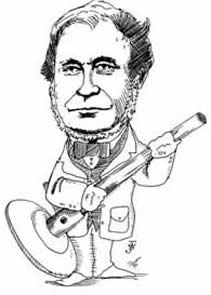
"Burner"
July 30, 2005
Robert Wilhelm Bunsen (1811-1899). German chemist. Professor of chemistry at the universities of Kassel (1836), Marburg (1841) and Heidelberg (1852-1889), Bunsen is perhaps best known for his work on spectrum analysis (1860), done in collaboration with the German physicist, Gustav Kirchhoff, and their subsequent discovery of the elements cesium (1860) and rubidium (1861). He also did notable work on the chemistry of organoarsenic compounds (1837-1842),the laws of photochemistry (1855-1867), and the refinement of gas analysis (1857). Known to students of general chemistry for his introduction of the tubular laboratory gas burner in 1855, Bunsen was a prolific inventor of chemical apparatus, including the Bunsen carbon battery (1841), the grease-spot photometer (1843), the hydrogen chloride actinometer (1857), and an improved ice calorimeter (1870).
Courtesy of Professor William Jensen, Oesper Chair of the History of Chemistry and Chemical Education, University of Cincinnati